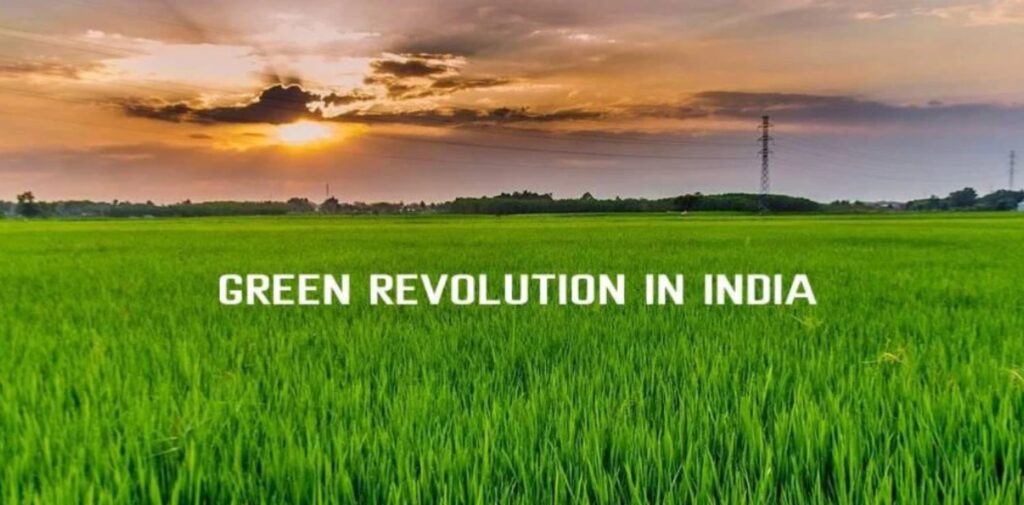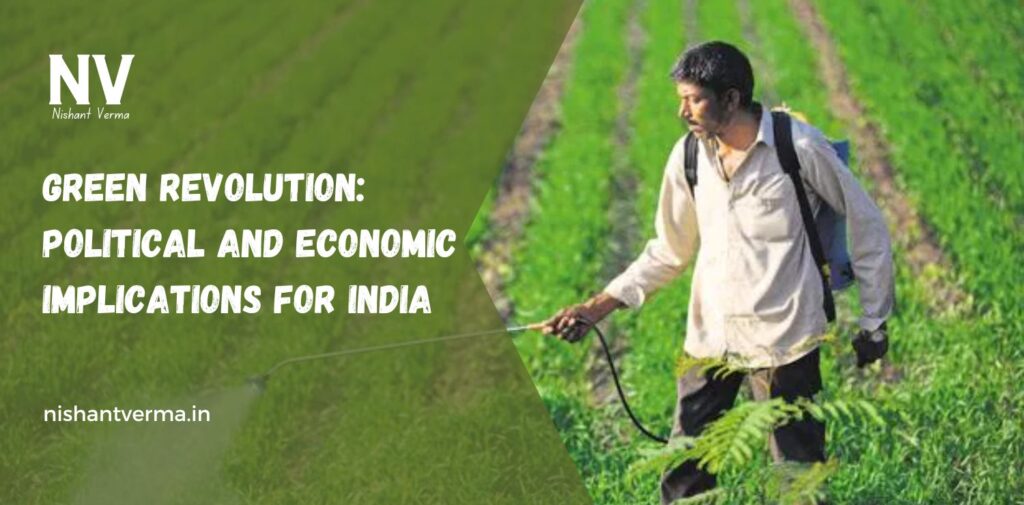In the 1960s, India faced a big challenge. The country was struggling to feed its growing population, and there was a fear that people might go hungry. The country’s agriculture was not producing enough food, and this led to food shortages, rising prices, and even famine in some regions. To address this problem, India introduced something called the Green Revolution.
This was a period of great changes in farming, where new farming techniques, better seeds, and modern technology were introduced to increase food production. But the Green Revolution was not just about growing more crops; it also had political and economic effects that changed the country in many ways. In this article, we will explore the Green Revolution and its political and economic implications for India in a simple and easy way.
What Was the Green Revolution?
The Green Revolution refers to a set of changes in farming practices that began in India in the 1960s. The revolution aimed to increase agricultural production by introducing new methods of farming and using advanced technologies. Some of the main features of the Green Revolution included:
- High-yielding Varieties (HYVs) of Seeds: These are special seeds that were developed to produce more food than traditional seeds. For example, wheat and rice varieties were developed that could grow faster and yield more crops.
- Use of Chemical Fertilizers and Pesticides: Farmers began using fertilizers to make the soil richer and pesticides to protect the crops from pests and diseases.
- Irrigation: Better irrigation methods were introduced to ensure that crops had enough water, even during dry seasons.
- Mechanization of Farming: Tractors, harvesters, and other machines were introduced to make farming easier and more efficient.
These changes helped farmers grow more food, which was important for feeding the growing population. But the Green Revolution also had far-reaching political and economic effects that affected different parts of India in various ways.

Political Implications of the Green Revolution
While the Green Revolution helped solve some of India’s food problems, it also brought about several political changes. Let’s look at the main political implications:
- Reduced Dependence on Food Imports: Before the Green Revolution, India relied on importing food from other countries, especially the United States. This was because the country did not produce enough food to feed its population. But after the Revolution, India became self-sufficient in food production. This meant that the government no longer had to depend on other countries for food, which gave India more control over its own resources. Politically, this was a big achievement because it helped India become less dependent on foreign countries for survival.
- Strengthening of the Government’s Position: The Green Revolution helped India avoid food crises and hunger, which was important for the political stability of the country. It also strengthened the government’s position because people saw the government as being capable of solving the food problem. Political leaders were able to gain popularity by promoting agricultural growth, and the Green Revolution became an important tool for gaining support from rural areas.
- Political Inequality Between Regions: The benefits of the Green Revolution were not felt equally across the country. Some regions, especially in Punjab, Haryana, and Western Uttar Pradesh, saw a big increase in agricultural production due to better irrigation, better seeds, and modern farming techniques. These areas became more prosperous and gained political power. However, many poor and dry regions, especially in the Deccan Plateau and parts of the Eastern and Southern states, did not benefit as much from the Green Revolution. These regions faced problems like less irrigation and poorer soil, which meant they did not see the same increase in food production. This created political inequality because regions that benefited from the Green Revolution had more resources, political influence, and economic power compared to regions that did not.
- Strengthening of Farmer Organizations: As agriculture became more productive, farmers became more powerful in certain regions. In areas like Punjab, where agriculture thrived, farmers were able to organize and voice their concerns to the government. This led to the rise of farmer organizations that pushed for better policies, subsidies, and support from the government. These organizations played a significant role in the political scene, especially in the 1970s and 1980s.

Economic Implications of the Green Revolution
The Green Revolution had a huge impact on India’s economy. Let’s explore the economic implications in detail:
- Increase in Agricultural Productivity: The most obvious economic benefit of the Green Revolution was a huge increase in agricultural productivity. New seeds, fertilizers, and better farming techniques led to much higher crop yields. Farmers in regions like Punjab and Haryana were able to produce much more food than before. This helped India to feed its growing population and even export food to other countries.
- Boost to the Indian Economy: The increase in food production had a positive impact on the Indian economy as a whole. With more food being produced, the government could use its resources for other important areas like industrial development, education, and healthcare. The agricultural sector became more productive, and this helped in the overall growth of the economy.
- Economic Inequality Between Farmers: While they helped some farmers, it also increased economic inequality. Farmers who had access to irrigated land, good seeds, and modern farming equipment were able to produce more crops and make more money. However, farmers who did not have access to these resources, such as those in dry or less developed areas, were left behind. This gap between rich and poor farmers grew larger, as those who could afford to buy modern technology and fertilizers became richer, while others remained poor. This led to increased economic disparity in rural areas, and many poorer farmers struggled to survive.
- Growth of the Rural Economy: The Green Revolution also led to the growth of the rural economy in areas where it was successful. As farmers produced more crops, they needed more workers, and this created jobs in rural areas. This helped improve the living standards of many people in farming communities, who were able to earn better wages and live more comfortable lives.
- Impact on the Environment: While the Green Revolution led to greater food production, it also had negative environmental effects. The widespread use of chemical fertilizers and pesticides led to soil degradation and water pollution. Over time, the land became less fertile, and the water used for irrigation became polluted with chemicals. This created long-term challenges for the environment and made farming less sustainable in the long run.

Challenges and Criticisms of the Green Revolution
The Green Revolution was not without its problems and criticisms. Some of the main challenges include:
- Environmental Damage: The excessive use of chemical fertilizers and pesticides caused harm to the soil and water. This made farming less sustainable in some areas.
- Widening Gap Between Rich and Poor Farmers: The Green Revolution benefited wealthier farmers who could afford new technology, while poorer farmers struggled to keep up. This increased the divide between rich and poor.
- Limited Benefits for Some Regions: The Green Revolution was not successful everywhere in India. Many regions, especially those with dry land or poor irrigation, did not see the same benefits.
Conclusion
The Green Revolution had both positive and negative effects on India’s political and economic landscape. On the one hand, it helped India become self-sufficient in food production, improved agricultural productivity, and contributed to economic growth. On the other hand, it created political inequality between regions, increased economic disparity between farmers, and caused long-term environmental damage.
Despite these challenges, the Green Revolution played a crucial role in shaping modern India’s agricultural policies and laid the foundation for future agricultural development. It also highlighted the need for more sustainable farming practices that can benefit all farmers, protect the environment, and ensure food security for future generations.




